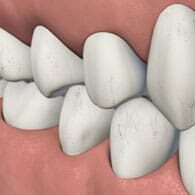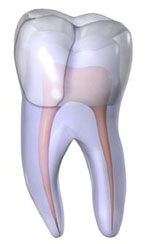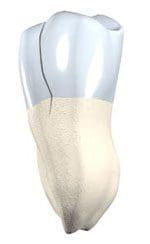Cracked Teeth
Cracked Teeth
Today, people live longer and more stressful lives than in the past. They expose their teeth to many more years of damage from such behaviors as clenching their teeth, grinding them or chewing on hard objects. While these habits make our teeth more susceptible to cracks, the good news is that dentists are helping people keep their teeth longer with sophisticated dental procedures.
How will my cracked tooth be treated?
The type of cracked tooth and the damage sustained from it varies from patient to patient. The type, location and extent of the crack will determine the treatment and outcome for your tooth. Some categories of cracked teeth are:

Craze lines
Craze lines are extremely common in adult teeth. They are very shallow, tiny cracks that affect only the outer enamel. They cause no pain and are of concern only because of appearance.

Fractured Cusp
The cusp of your tooth is the pointed part of the chewing surface. With a Fractured Cusp, the cusp is weak, resulting in a fracture and causing pain. Your dentist may have to remove the weakened cusp or it may break off by itself. Either way, the pain will usually be relieved. Root canal treatment is usually not needed since a fractured cusp rarely damages the pulp. Your dentist will restore your tooth with the appliance of a full crown.

Cracked Tooth
With a cracked tooth, the crack extends vertically from the chewing surface of the tooth down towards the root. Early diagnosis of this condition is important, because an untreated crack in a tooth will become worse over time, eventually resulting in the loss of the tooth. It is sometimes difficult to determine the extent of a crack, even with high magnification and special lighting, but early diagnosis and treatment are essential in saving these teeth. Because of the position of the crack, damage to the pulp is common even though a cracked tooth is not completely separated into two distinct segments. The crack may extend below the gingival tissue line, making extraction of the damaged tooth necessary, but more frequently, root canal treatment is used to treat the injured pulp. Your dentist can restore your tooth with a crown that holds the pieces together and protects the cracked tooth.

Split Tooth
A split tooth is often the result of a cracked tooth that is not diagnosed early. The crack in the tooth worsens until the tooth splits into distinct segments that can be separated. A split tooth cannot be saved intact. Some portion of the tooth may be saved, depending on the position and extent of the crack. Endodontic treatment and a crown or other restoration by your dentist may be used to save a portion of the tooth, but this is rare.

Verticle Root Fracture
A vertical root fracture is formed by cracks that move from the inside out. These cracks begin in the root of the tooth and extend upward toward the chewing surface. They frequently go unnoticed because they show minimal signs and symptoms. The surrounding bone and gum may become infected before vertical root fractures are discovered. Removal of part of the fractured root with endodontic surgery may save a portion of the tooth, but frequently, treatment involves extraction of the tooth.